Abstract
To evaluate the effect of Ca++ on renin release, plasma renin activity (PRA) was measured after acute and chronic Ca++ administration. 1% CaCl2 was infused into one renal artery of 10 anesthetized dogs (0.3 mg/kg/min). The excreted fraction of filtered calcium (EFca++) and EFNa+ from the infused kidney were elevated (P < 0.04) during three successive 15-min infusion periods. Serum calcium concentration was significantly elevated (P < 0.001). Creatinine clearance, systemic arterial pressure, and renal blood flow did not change (P > 0.10). Compared to control (45 ng/ml/h±5.2 SE), renal venous PRA was suppressed (P < 0.0001) after infusion of Ca++ for 15, 30, and 45 min (20 ng/ml/h±4.6, 16 ng/ml/h±4.0, and 13 ng/ml/h±2.7, respectively). 15 and 30-min after infusion, PRA did not differ from control (P > 0.20). Chronic Ca++ loading was achieved in Sprague-Dawley rats by replacing drinking water with 1% CaCl2 for 17 days. At sacrifice, serum Ca++, Na+, and K+ of controls (n = 12) did not differ (P > 0.60) from Ca++-loaded rats (n = 12). Ca++ excretion (467 μeq/24 h±51) was elevated (P < 0.001) compared to controls (85 μeq/24 h±12). PRA (8.6 ng/ml/h±1.4) and renal renin content of Ca++-loaded rats did not differ from controls (P > 0.80). However, after 8 days of sodium deprivation, both PRA and renal renin content of calcium-loaded animals were significantly lower than the respective values in pair-fed controls (P < 0.005). During the period of sodium deprivation, calcium-drinking animals were in greater negative sodium balance than controls (P < 0.005). The data are consistent with the hypothesis that acute and chronic calcium administration inhibit renin secretion.
Full text
PDF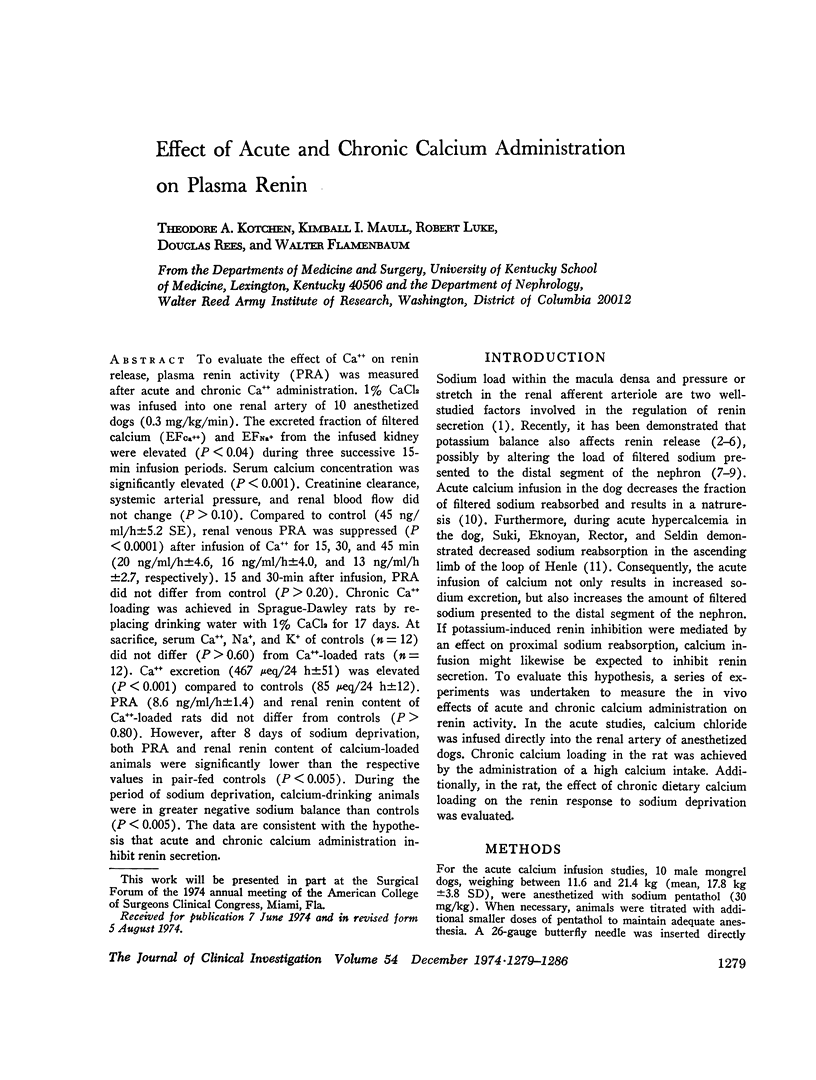
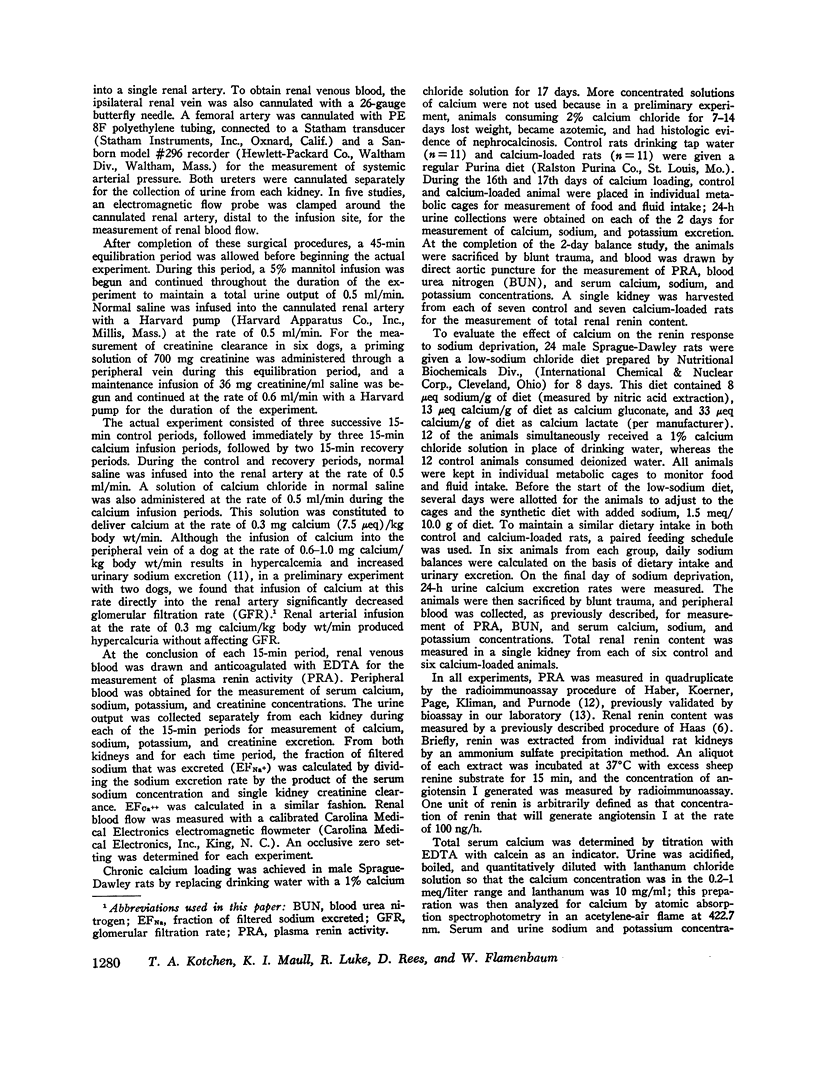
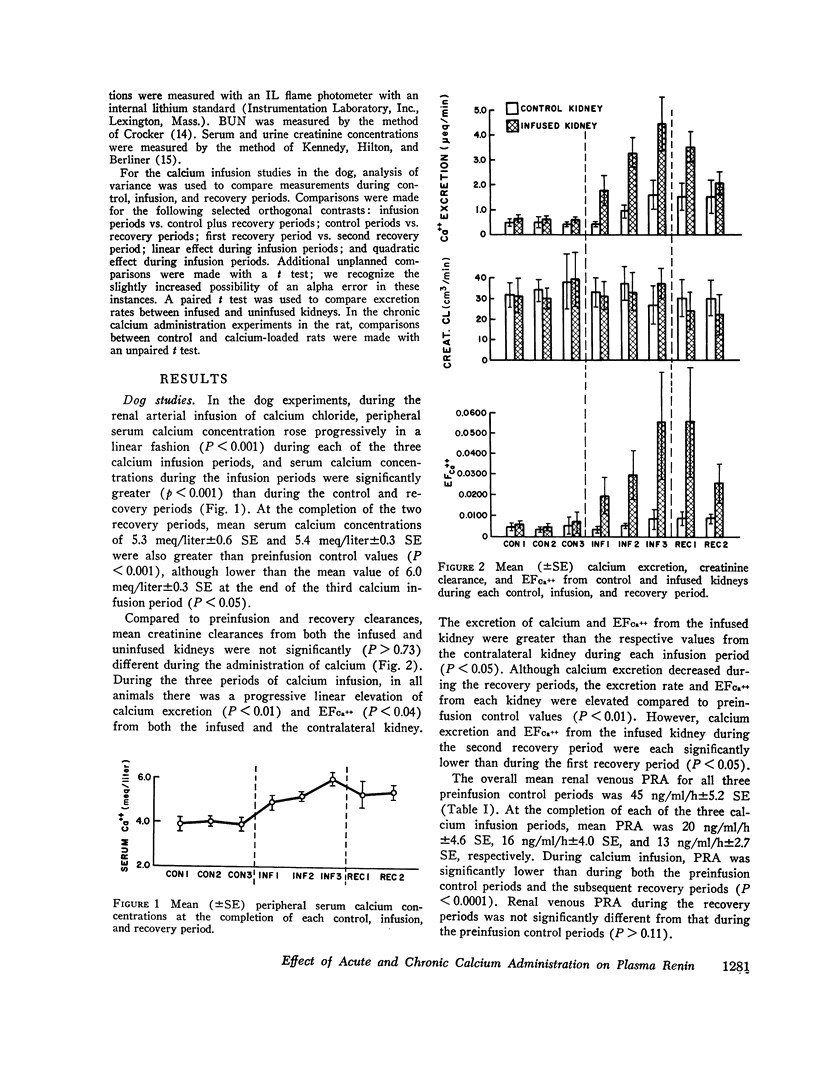
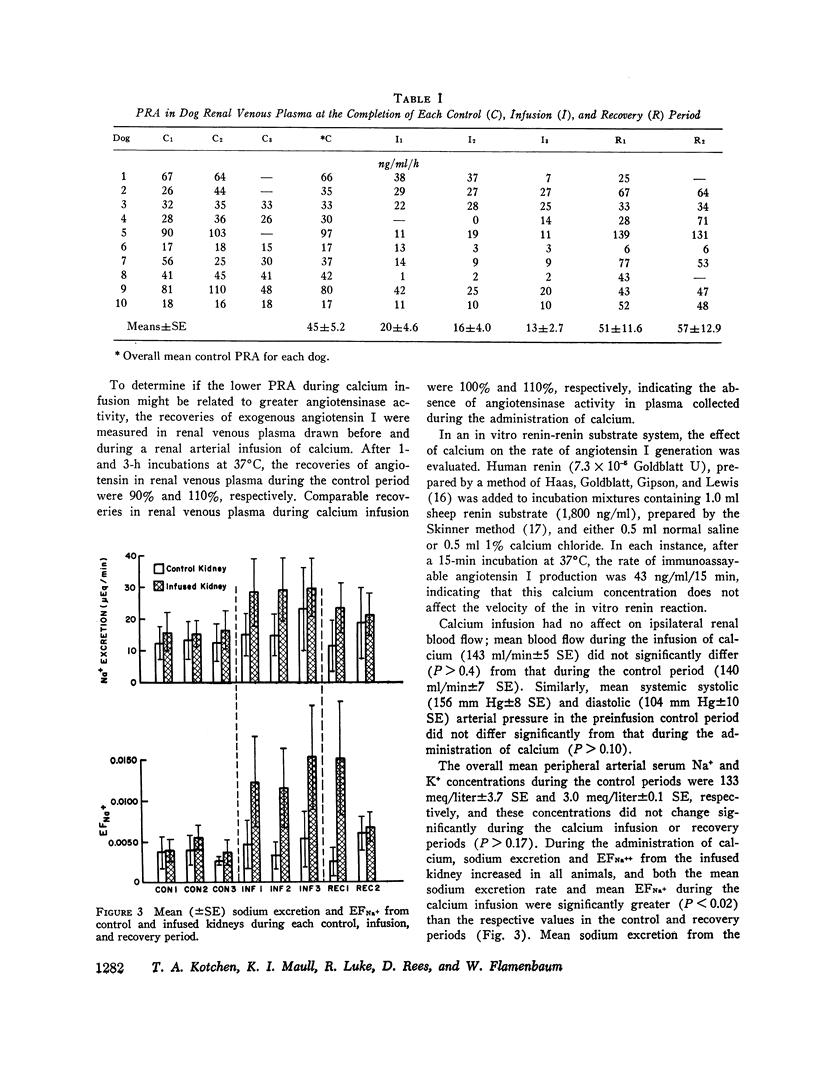
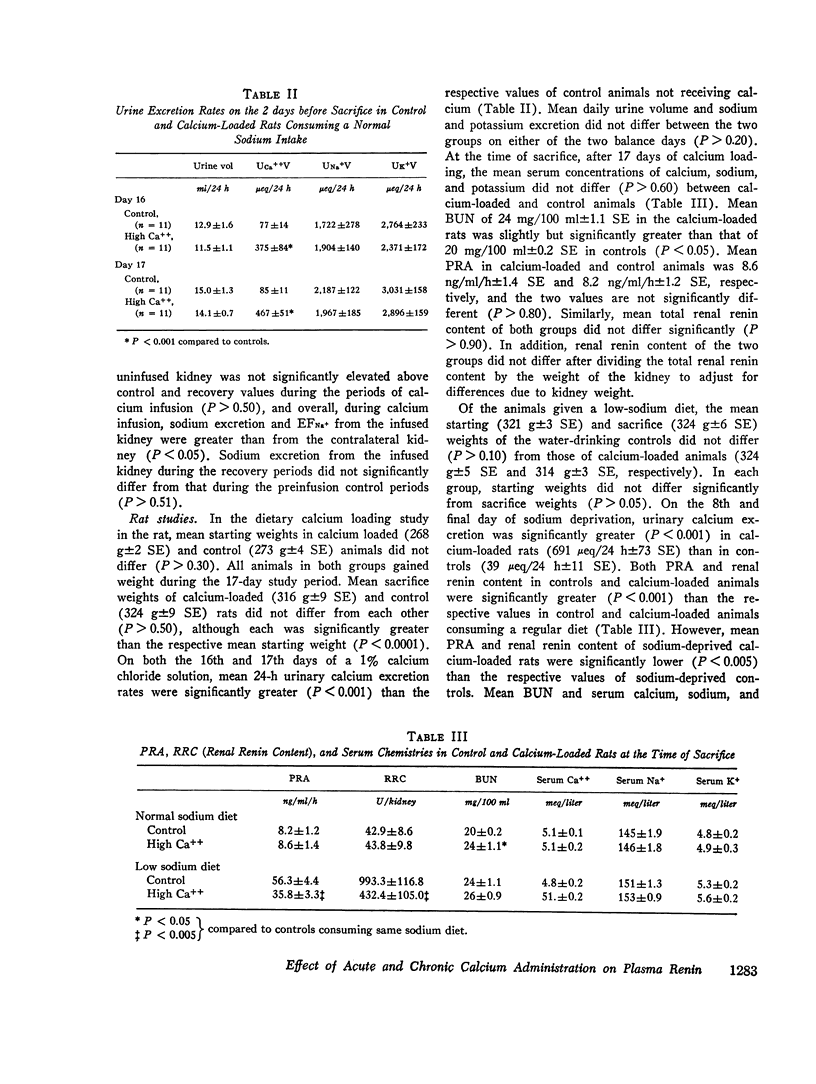
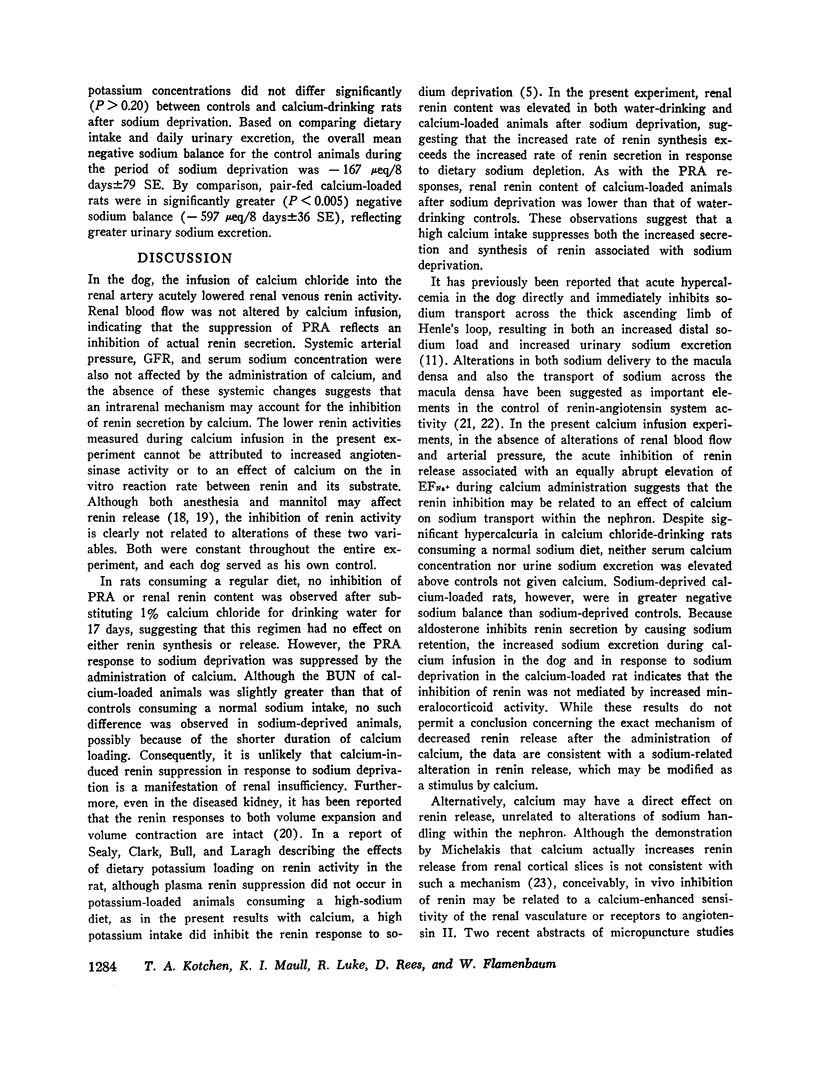
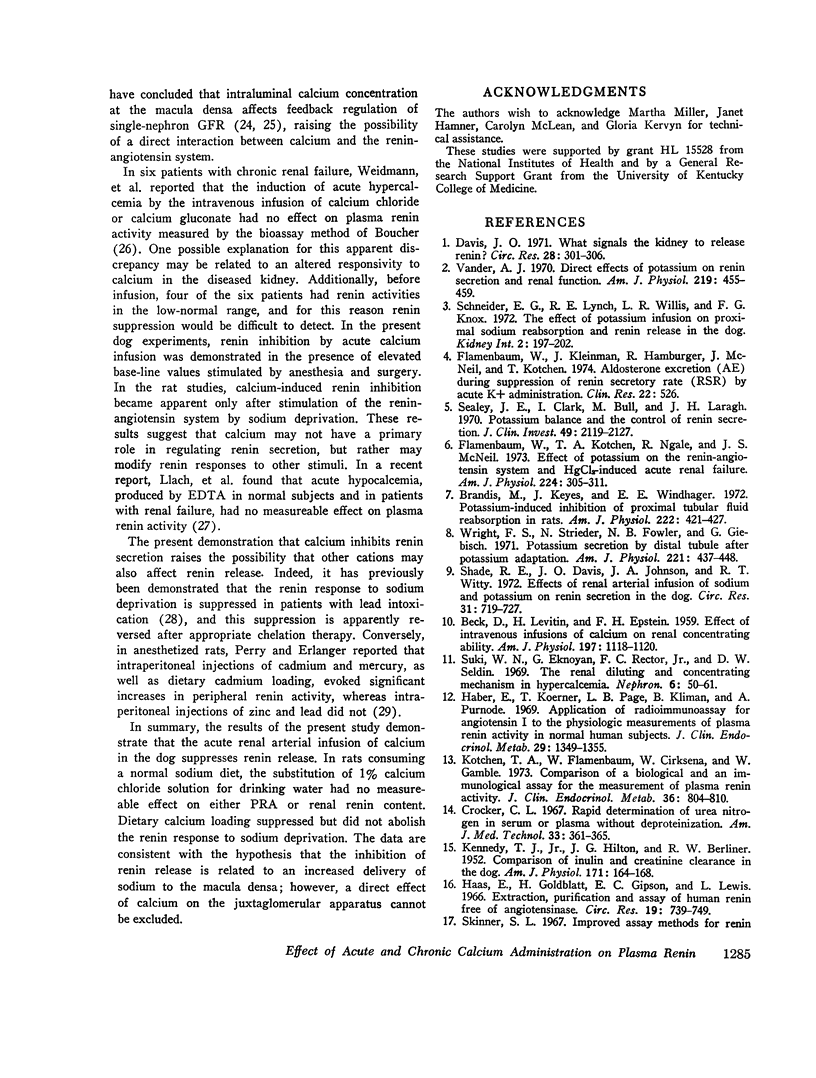
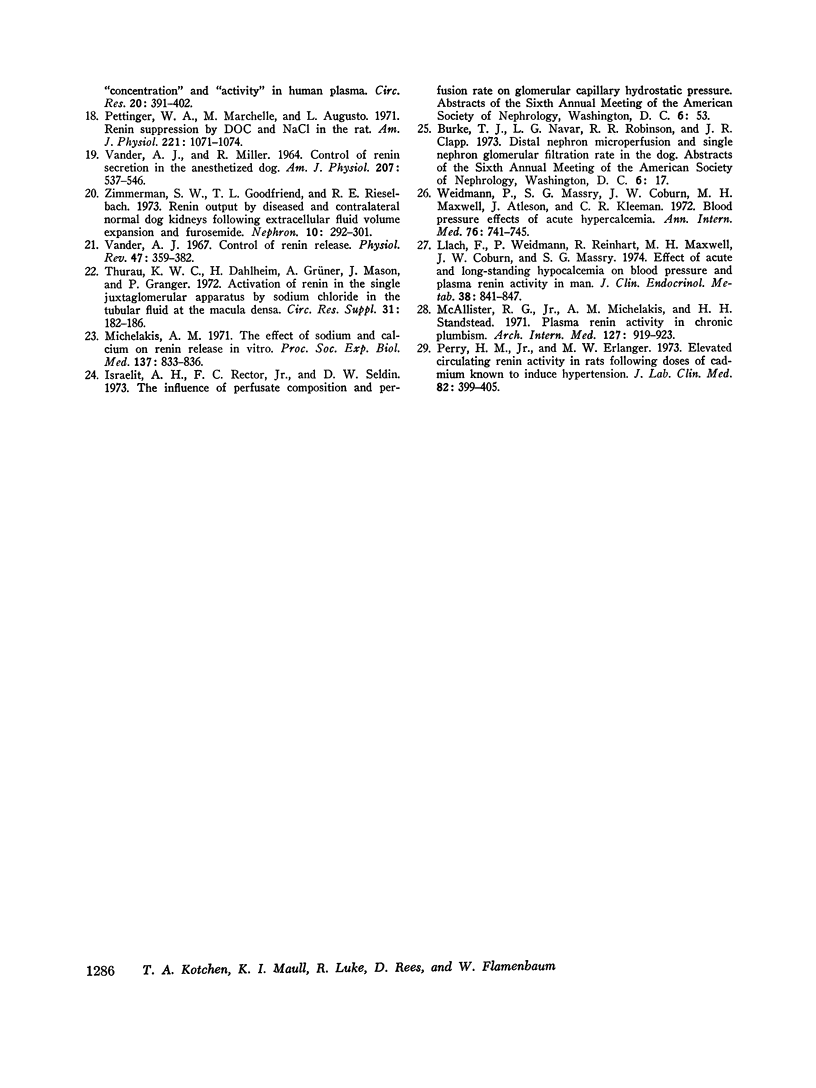
Selected References
These references are in PubMed. This may not be the complete list of references from this article.
- BECK D., LEVITIN H., EPSTEIN F. H. Effect of intravenous infusions of calcium on renal concentrating ability. Am J Physiol. 1959 Nov;197:1118–1120. doi: 10.1152/ajplegacy.1959.197.5.1118. [DOI] [PubMed] [Google Scholar]
- Brandis M., Keyes J., Windhager E. E. Potassium-induced inhibition of proximal tubular fluid reabsorption in rats. Am J Physiol. 1972 Feb;222(2):421–427. doi: 10.1152/ajplegacy.1972.222.2.421. [DOI] [PubMed] [Google Scholar]
- Crocker C. L. Rapid determination of urea nitrogen in serum or plasma without deproteinization. Am J Med Technol. 1967 Sep-Oct;33(5):361–365. [PubMed] [Google Scholar]
- Davis J. O. What signals the kidney to release renin? Circ Res. 1971 Mar;28(3):301–306. doi: 10.1161/01.res.28.3.301. [DOI] [PubMed] [Google Scholar]
- Flamenbaum W., Kotchen T. A., Nagle R., McNeil J. S. Effect of potassium on the renin-angiotensin system and HgCl 2 -induced acute renal failure. Am J Physiol. 1973 Feb;224(2):305–311. doi: 10.1152/ajplegacy.1973.224.2.305. [DOI] [PubMed] [Google Scholar]
- Haas E., Goldblatt H., Gipson E. C., Lewis L. Extraction, purification, and assay of human renin free of angiotensinase. Circ Res. 1966 Oct;19(4):739–749. doi: 10.1161/01.res.19.4.739. [DOI] [PubMed] [Google Scholar]
- Haber E., Koerner T., Page L. B., Kliman B., Purnode A. Application of a radioimmunoassay for angiotensin I to the physiologic measurements of plasma renin activity in normal human subjects. J Clin Endocrinol Metab. 1969 Oct;29(10):1349–1355. doi: 10.1210/jcem-29-10-1349. [DOI] [PubMed] [Google Scholar]
- KENNEDY T. J., Jr, HILTON J. G., BERLINER R. W. Comparison of inulin and creatinine clearance in the normal dog. Am J Physiol. 1952 Oct;171(1):164–168. doi: 10.1152/ajplegacy.1952.171.1.164. [DOI] [PubMed] [Google Scholar]
- Kotchen T. A., Flamenbaum W., Cirksena W., Gamble W. Comparison of a biological and an immunological assay for the measurement of plasma renin activity. J Clin Endocrinol Metab. 1973 May;36(5):804–810. doi: 10.1210/jcem-36-5-804. [DOI] [PubMed] [Google Scholar]
- Llach F., Weidmann P., Reinhart R., Maxwell M. H., Coburn J. W., Massry S. G. Effect of acute and long-standing hypocalcemia on blood pressure and plasma renin activity in man. J Clin Endocrinol Metab. 1974 May;38(5):841–847. doi: 10.1210/jcem-38-5-841. [DOI] [PubMed] [Google Scholar]
- McAllister R. G., Jr, Michelakis A. M., Sandstead H. H. Plasma renin activity in chronic plumbism. Effect of treatment. Arch Intern Med. 1971 May;127(5):919–923. [PubMed] [Google Scholar]
- Michelakis A. M. The effect of sodium and calcium on renin release in vitro. Proc Soc Exp Biol Med. 1971 Jul;137(3):833–836. doi: 10.3181/00379727-137-35677. [DOI] [PubMed] [Google Scholar]
- Perry H. M., Jr, Erlanger M. W. Elevated circulating renin activity in rats following doses of cadmium known to induce hypertension. J Lab Clin Med. 1973 Sep;82(3):399–405. [PubMed] [Google Scholar]
- Pettinger W. A., Marchelle M., Augusto L. Renin suppression by DOC and NaCl in the rat. Am J Physiol. 1971 Oct;221(4):1071–1074. doi: 10.1152/ajplegacy.1971.221.4.1071. [DOI] [PubMed] [Google Scholar]
- Schneider E. G., Lynch R. E., Willis L. R., Knox F. G. The effect of potassium infusion on proximal sodium reabsorption and renin release in the dog. Kidney Int. 1972 Oct;2(4):197–202. doi: 10.1038/ki.1972.95. [DOI] [PubMed] [Google Scholar]
- Sealey J. E., Clark I., Bull M. B., Laragh J. H. Potassium balance and the control of renin secretion. J Clin Invest. 1970 Nov;49(11):2119–2127. doi: 10.1172/JCI106429. [DOI] [PMC free article] [PubMed] [Google Scholar]
- Shade R. E., Davis J. O., Johnson J. A., Witty R. T. Effects of renal arterial infusion of sodium and potassium on renin secretion in the dog. Circ Res. 1972 Nov;31(5):719–727. doi: 10.1161/01.res.31.5.719. [DOI] [PubMed] [Google Scholar]
- Skinner S. L. Improved assay methods for renin "concentration" and "activity" in human plasma. Methods using selective denaturation of renin substrate. Circ Res. 1967 Apr;20(4):391–402. doi: 10.1161/01.res.20.4.391. [DOI] [PubMed] [Google Scholar]
- Suki W. N., Eknoyan G., Rector F. C., Jr, Seldin D. W. The renal diluting and concentrating mechanism in hypercalcemia. Nephron. 1969;6(1):50–61. doi: 10.1159/000179715. [DOI] [PubMed] [Google Scholar]
- Thurau K. W., Dahlheim H., Grüner A., Mason J., Granger P. Activation of renin in the single juxtaglomerular apparatus by sodium chloride in the tubular fluid at the macula densa. Circ Res. 1972 Sep;31(9 Suppl):182–186. [PubMed] [Google Scholar]
- VANDER A. J., MILLER R. CONTROL OF RENIN SECRETION IN THE ANESTHETIZED DOG. Am J Physiol. 1964 Sep;207:537–546. doi: 10.1152/ajplegacy.1964.207.3.537. [DOI] [PubMed] [Google Scholar]
- Vander A. J. Control of renin release. Physiol Rev. 1967 Jul;47(3):359–382. doi: 10.1152/physrev.1967.47.3.359. [DOI] [PubMed] [Google Scholar]
- Vander A. J. Direct effects of potassium on renin secretion and renal function. Am J Physiol. 1970 Aug;219(2):455–459. doi: 10.1152/ajplegacy.1970.219.2.455. [DOI] [PubMed] [Google Scholar]
- Weidmann P., Massry S. G., Coburn J. W., Maxwell M. H., Atleson J., Kleeman C. R. Blood pressure effects of acute hypercalcemia. Studies in patients with chronic renal failure. Ann Intern Med. 1972 May;76(5):741–745. doi: 10.7326/0003-4819-76-5-741. [DOI] [PubMed] [Google Scholar]
- Wright F. S., Strieder N., Fowler N. B., Giebisch G. Potassium secretion by distal tubule after potassium adaptation. Am J Physiol. 1971 Aug;221(2):437–448. doi: 10.1152/ajplegacy.1971.221.2.437. [DOI] [PubMed] [Google Scholar]
- Zimmerman S. W., Goodfriend T. L., Rieselbach R. E. Renin output by diseased and contralateral normal dog kidneys following extracellular fluid volume expansion and furosemide. Nephron. 1973;10(5):292–301. doi: 10.1159/000180200. [DOI] [PubMed] [Google Scholar]


